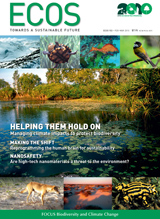
|
Published:
Traffic noise wiping out Melbourne’s frogs?
New research led by Kirsten Parris from the Applied Environmental Decision Analysis hub1 has found that traffic noise is drowning out the mating call of some frogs, and could be one of the reasons for the large-scale decline of frog populations in Melbourne.
Mathematical modelling predicts that in areas with lots of traffic noise, male pobblebonk frogs that could once be heard by females some 800 metres away can now only be heard within 14 metres. Just like humans trying to attract a mate in a noisy bar, this acoustic interference might be causing havoc with their social life.
Dr Parris, who is based at the University of Melbourne, made the discovery while undertaking research on nine frog species in public ponds in and around Melbourne.
‘Being heard is important,’’ she said. ‘If the females can’t hear the male frogs then they have less chance of breeding successfully.’
Frogs with low-frequency calls are particularly affected, given that most urban noise – from traffic to air conditioners – comes across as a low rumble.
In response to this threat, it appears that some frogs are changing their calls. With Honours students, Meah Velik-Lord and Joanne North, Dr Parris found that the southern brown tree frog was adapting to urban noise by producing a squeakier and higher-pitched call. This new call helps them to be heard, but does not completely make up for the effect of traffic noise.
After monitoring 50 sites around Melbourne, Dr Parris says Kew Billabong in the inner-eastern suburbs might be the worst place for calling frogs because of the nearby Eastern Freeway.
Mount Macedon and the far-eastern suburbs, such as Belgrave, are much easier places for frogs to be heard, as they have little traffic.
‘I’ve been studying frogs in Melbourne since 2000,’ says Dr Parris. ‘Recently my colleague Dr Andrew Hamer, from the Australian Research Centre for Urban Ecology (ARCUE), revisited some of my original sites and found that whole populations have disappeared.
‘This is what’s known as local extinction, and it’s possible that urban noise is contributing to this process.’
It’s not just noise conspiring against the frogs. Dr Parris says several species, including the threatened growling grass frog, are struggling in and around drought-affected Melbourne.
‘Year after year, there’s not enough water for them to breed successfully,’ she explains.
‘Eventually the frog population declines to nothing, and roads and other barriers in the urban environment prevent new frogs from moving into those ponds. So even if they fill with water again, they stay empty of frogs.’
With climate change forecasts of reduced rainfall for many of our cities, the frogs’ predicament is expected to worsen. This is why Dr Parris and colleagues have started a pilot program with the Melbourne Zoo and the Royal Botanic Gardens Melbourne that aims to put frogs back into urban areas where they have disappeared.
However, for such programs to be effective it’s important that we understand the impacts and threats posed by urban noise.
‘Frogs are a very important part of the ecosystem, and some species are also very sensitive to environmental changes,’ says Dr Parris.
‘It’s often said that frogs are our canary in the coalmine, providing an early indication that all is not well in the environment. Well, these ‘canaries’ are falling off the perch, so maybe it’s time we started heeding the warning.’
Dr Parris says the environment is not her only motivation for trying to repopulate Melbourne’s ponds with frogs.
‘The sound of calling frogs makes many people happy. Hearing frogs provides a small connection with nature, one that is quite precious to anyone living in a big city.’
More information:
Parris KM, M Velik-Lord, and JMA North (2009). Frogs call at a higher pitch in traffic noise. Ecology and Society 14(1), 25. www.ecologyandsociety.org/vol14/iss1/art25/
1 The Applied Environmental Decision Analysis (AEDA) research hub, funded through the Commonwealth Environment Research Facilities (CERF) program, brings together quantitatively-oriented conservation ecologists based at universities in Brisbane, Canberra and Melbourne.




